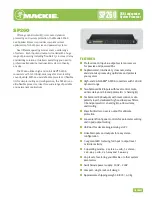
Chapter 9 |
47
Advanced Processing Controls
Foreground Sounds Coefficient
All programming has what is sometimes referred to as an “anchor element,” that is, the audio content to which the viewer
will pay the most attention. This is typically (though not always) dialog. This is also referred to as “foreground” audio to
differentiate it from background audio, or in some cases, noise.
The
Foreground Sounds Coefficient control
(G) sets the level in the Dynamic Range processing stage at which program
audio is no longer considered a foreground sound relative to both the lower border as set by the
Null Area Coefficient
control
(described in detail below)
and a minus infinite level (full silence) on a proportional scale.
For example, if the
Target level
is set to -23dB LUFS, the
Null Area Coefficient
is set to 4, and the
Foreground Sounds
Coefficient
is set to 2, any audio between -27 and -25dB will be deemed foreground audio and therefore be raised toward the
target.
Audio at levels lower than -27dB will still be increased toward the target, but the degree to which gain is increased slows down
considerably. The lower the audio is from -27dB, the less the gain will increase.
Null Area Coefficient
The primary goal of the APTO processing within ARC is to deliver a consistent
average
output level as set by the Target Level
control. This does not mean, however, that the actual output audio level must never deviate from this value. In fact, a certain
amount of dynamic range helps preserve the artistic integrity of the original programming and makes for a more engaging
audio experience for the viewer.
One of the things that makes APTO different from traditional processing is its ability to “do nothing” to audio levels when no
action is required to maintain the correct average output level. This avoids the “busy” sound of traditional compressors and
ACGs which by their very nature are always operating either over or under a threshold, and therefore always increasing or
decreasing gain - often for no good reason.
The
Null Area Coefficient control
(D) sets the lower and upper thresholds that together determine the size of the window in
which APTO’s Dynamic Range processing stage neither increases nor decreases gain, with the user-determined Target level
sitting in the middle of the range. Values are in dB, with larger values resulting in a larger “do nothing” window.
Compliance Speed
How quickly gain changes are made in the Compliance processing stage are largely program dependent. However, the
maximum rate at which the gain can increase or decrease is set by the
Compliance Speed control
(E). The rate is calibrated in
dB (or LU) per second.
Higher values (from 2 – 6 LU per second) allow compliance to be achieved more quickly but may introduce audible gain
changes to the average program level in the process. These faster settings are best suited for situations when input levels are
expected to be very inconsistent.
Lower values (from 0.2 to 2 LU per second) provide a subtler and more natural-sounding normalization but may result in gain
changes that are too slow and allow the audio to remain outside of the comfort zone for too long. Slower settings work well for
content that is more consistent and well-controlled. They are also recommended for long-form content such as feature films or
classical music.
Average Maximum Gain
The
Average Maximum Gain control
(F) sets the maximum amount of positive gain (gain increase) applied in the
Compliance processing stage in order to reach the Target level.
Larger values will allow very soft program segments to be raised by a greater amount, but whether or not this is desirable must
be considered. For instance, some material may have been purposefully kept at a lower level for dramatic effect, and of course
there is always the risk of increasing unwanted background noise.
Содержание LINEAR ACOUSTIC ARC
Страница 8: ......
Страница 10: ......
Страница 12: ......
Страница 22: ......
Страница 37: ...Chapter 5 27 Remote User Interface Figure 5 12 PTP menu...
Страница 38: ......
Страница 48: ......
Страница 60: ......
Страница 64: ......
Страница 67: ...Chapter 11 57 Addendum 1 Figure A1 2 Logging menu...
Страница 68: ......
Страница 70: ......
Страница 71: ......















































